With so many different deer feeder models on the market, choosing the best deer feeder for your individual needs can be a challenging and confusing process. One of the more popular deer feeder styles is the hanging deer feeder. In this article, I’ll go over my recommended five best hanging deer feeder models, including a look at the factors that go into my top 5 models.
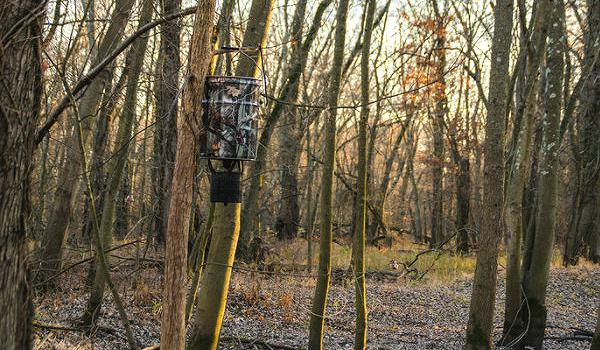
What is a Hanging Deer Feeder?
Before I get into listing my favorite hanging feeders, let’s take the time to define a hanging deer feeder.
A hanging deer feeder is a specific style of deer feeder that is suspended from a higher object (usually a tree or post) and dispenses some type of deer feed.
This style of deer feeder is very popular, especially for locations where a tripod-style feeder or gravity-style feeder is not ideal. In addition, when correctly configured, hanging feeders are more manageable for a single person to refill compared to some other feeder styles.
Handing feeders are usually suspended anywhere from 4 feet up to 12 feet off the ground (and I’ll get more into my idea of the ideal height for a suspended deer feeder down below.)
Pros and Cons of a Hanging Feeder
No deer feeder is perfect, and the hanging-style feeders are no different. Like any other feeder setup, hanging feeder models come with pros and cons.
Here is a look at all the pros and cons, along with some explanations of each:
Pros
Easier to set up and refill than some other feeder styles
I find hanging feeders to be one of the easiest to set up and manage, especially for an individual without any help.
The feeders themselves tend to be relatively lightweight and simpler to transport than some other feeder styles. Most hanging-style feeders use a chain, wire, or rope system to raise and lower the feeder off the ground. That same system makes it easy to lower the feeder to ground level for hassle-free feed refilling.
Ideal for uneven ground or hard-to-reach locations
The lighter weight and smaller size of this feeder style make it a good option for areas where the ground is uneven or too unstable to support another type of feeder, like a tripod-style feeder.
A hanging feeder can also be an excellent option in areas that are hard to reach with a vehicle, 4-wheeler, or 3-wheeler. In situations where you have to carry the feeder in by hand, the more portable feeder option offered by a smaller hanging feeder can be advantageous.
The adjustable feeder height can help with varmint control of some species
Hanging the feeder at higher heights (say 8 to 9 feet and up) can offer some protection from bears (although a bear will go to great lengths to break into a feeder if they are hungry).
A hanging feeder is also effective as a potential deterrent for wild hogs or pigs. While it won’t keep them from eating the feed, a hanging-style feeder eliminates the opportunity for pigs to knock the feeder over.
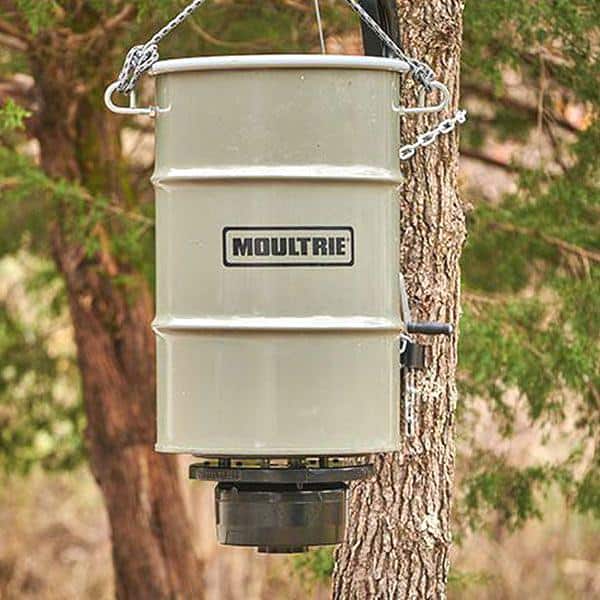
Cons
Smaller feed reservoir
Due to the design, many hanging feeders feature a smaller feed reservoir than some other feeder styles, equating to a higher frequency of necessary feed refills or restocking. For example, a 30-gallon hanging feeder will most likely have to be refilled or restocked with feed more often than a 100-gallon tripod-style feeder.
This can involve more trips to the feeder, which can or may spook deer as a trickle-down effect.
Most do not come equipped with a solar charging option
Nearly all the hanging feeders that I suggest feature a spinning or rotating feed dispersal function, which is/are battery-powered. When the battery or batteries die, the feeder stops working. One popular alternative to standard batteries is to utilize rechargeable batteries and a solar charging panel that will recharge the batteries.
Most of the hanging style feeders are not equipped with solar battery charging capability. However, this option can be added via a 3rd party solar panel, but that’s an added expense.
Solar charging is a great option when available as it means fewer dead batteries and fewer trips to replace dead batteries.
May be difficult to hoist up into position without a winch of some kind
Something else to consider with a hanger deer feeder is the overall weight of the feed when filled with feed. I say that because you may be talking about a filled feeder with a total weight that exceeds 300 pounds or more. So, for example, if the feeder weighs 45 pounds by itself and holds 200 pounds of feed, you have a minimum total weight of 245 pounds.
While some guys or girls may have no trouble hoisting that kind of weight, others may struggle with it. That’s one of the reasons that I prefer to use either a hoist or ratchet-style winch when dealing with feeders weighing over 200 pounds.
For each hanging deer feeder model discussed below, I’ve included some basic information, along with the features or things that I like and don’t like about each model. I’ve also included some additional things to consider in a hanging feeder buying guide that can be seen down below.
Five Best Hanging Game Feeder Models
Model | Image | Capacity | Hopper Material | Shop |
Moultrie Super Pro Mag 30 Gallon Hanging Feeder | 30 Gallons | Steel | ||
On Time Elite Lifetime Hanging Feeder | 200 Pounds | Polymer/Plastic | ||
Wildgame Innovations Quick-Set 50 Hanging Pail Feeder | 50 Pounds | Steel | ||
On Time 74000 Shakedown Feeder | 10 Gallons | Polymer/Plastic | ||
Moultrie 6.5 Gallon Pro Hunter II Hanging Feeder | 6.5 Gallons | Steel |
Here’s a more in-depth look at each feeder on the list:
Moultrie 30-Gallon Super Pro Mag Hanging Feeder (Model 13458)
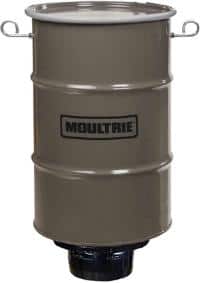
While Moultrie feeders offer several hanging deer feeder models, the 30 Gallon Super Pro Mag is one of my favorites. This model is somewhat of a 2nd generation version of the Moultrie Pro Magnum feeder. If you want to spend a little less money, then the Moultrie Pro Magnum feeder is an excellent alternative as well.
This unit features a steel barrel and steel top that holds up well to the elements (except for one issue, which I discuss below) and to critters other than deer.
Unlike some feeders that can be used in different methods, this model is specifically designed as a hanging feeder. It features a battery-operated digital timer that can be set to run up to 6 times per day, and the duration for each feed activation can be adjusted from 0-20 seconds.
The 30-gallon capacity (which equates to 200 pounds of corn) is enough to last for several weeks (or more), depending on how often you set the timer and how long each feed cycle duration runs. Of course, the more often the feeder runs per day, the more frequently it will have to be refilled.
The digital timer is located in a sealed housing and is relatively easy to access. This unit operates on two 6-volt batteries (which are not included) and will accept solar rechargeable batteries as well).
Pros
Flexible enough feed system to meet almost any need.
Rugged durable unit that will last for many years if properly maintained.
Weighs 42 lbs. so a single person can transport and set up relatively quickly.
Holds up well against attempted entry from squirrels and raccoons.
Cons
My major complaint with this model is the concave design of the lid. This design allows water to pool, which will eventually cause rust. I’ll discuss possible solutions and alternatives below.
This model does not include a mounting bracket or mounting gambrel, so you’ll have to purchase that separately.
The included varmint guard (varmint cage) is decent, but Moultrie offers a better guard model (at an additional cost).
Comes with a lifetime warranty, but it’s really more of a limited lifetime warranty with all the warranty exclusions.
Pooling water issue
For some people, this may not be a big deal, but the concave lid design drives me nuts because it potentially impacts the longevity of the feeder. I’ve had several people at my day job mention this issue to me. I understand the how and why it’s an issue, so here are a few potential solutions:
Treat the lid with some type of aftermarket coating that will help withstand the standing water that pools up. I’ve tried a few, and Bedliner spray or Duracoat seemed to work best for me.
Option number two is to purchase an aftermarket 30-gallon top built to shed rain. Moultrie does offer an upgraded lid for this unit, but it’s made of plastic, so squirrels can chew right through it. The one that I felt worked the best was the Ultramatic Feeders Galvanized 30-gallon barrel lid, which can be seen here. This lid is a much better design and quality than the standard Moultrie lid and works very well.
On Time Wildlife Feeders Elite Lifetime Hanging Feeder (Model 71537)
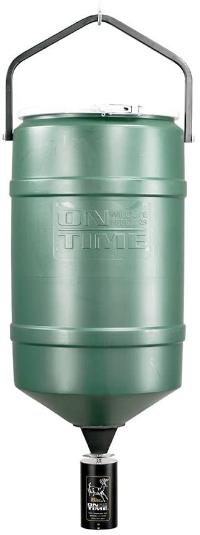
If you need an ultra-lightweight hanging feeder that can be transported and deployed by a single person, then this On Time Elite Hanging Feeder might be worth a look.
Weighing in at 20 pounds, this feeder is very easy to carry to your desired location and super simple to configure. It runs on an AA battery pack, but I’d strongly suggest moving up to the On Time C cell battery pack, as the C cell model lasts at least three times as long as the AA battery pack.
This model features a feeder unit that is adjustable and can support up to 6 individual feeding times per day.
The hopper (which is a fancy name for the barrel) holds 200 pounds of feed, and the feeder unit can handle almost any corn or commercially available dry feed.
Pros
Since the entire unit is polymer, it’s very lightweight for its size.
Easy to set up with simple instructions.
On Time Feeders uses a modular type design for its feeders. Therefore, if the feed motor goes out, there are easy to purchase and replace.
Cons
The polymer material is a pro and con as it’s lightweight but not as strong as steel. Because of that, this feeder is more vulnerable to pests (bears and squirrels) compared to a steel model.
This model does not come standard with a varmint guard, so you have to purchase one separately. Otherwise, squirrels may be able to get a paw into the feed motor and extract feed.
Like most hanging feeders, this model does not include a hanger unit, so you’ll have to purchase one or a gambrel separately.
Wildgame Innovations Quick-Set 50 Pail Feeder (Model WGIPF0012)
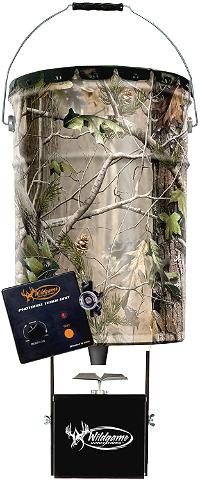
If you are in the market for a drop-dead simple hanging feeder that is one of the lightest models on the market and one of the easiest to deploy, then the Wildgame innovations Quick-Set 50 Pail Feeder could be of interest.
This feeder is basically a modified metal pail with a motorized feeder unit attached. Weighing only 8 pounds unloaded, you’ll be hard-pressed to find a more lightweight pail feeder.
One thing to be aware of with this model: Unlike most feeders on this list, this specific model is not programmable. The feeder is preset to activate twice a day, once at dawn and then again at dusk. It operates on a photocell timer, and you can set the feed duration from 5 seconds up to 20 seconds.
While most feeders use gallons as a feed measurement, this model uses pounds. The max capacity for this model is 50 pounds, which translates to about 6 gallons.
This model is an excellent option if you are on a strict budget but want an easy-to-configure and dependable pail-type feeder.
Pros
Possibly the lightest and easiest to transport bucket style hanging deer feeder on the market.
Extremely easy to configure and deploy.
A good option if you’re on a strict budget but need a portable hanging feeder.
Cons
Non-programmable motor and feed options. Only feeds at dawn and dusk.
While the pail and lid are metal, the seams where the metal meets together around the bucket are susceptible to rust. So I’d suggest sealing the seams with something that is waterproof.
Only holds 50 pounds (which is 6 gallons) of deer feed.
On Time 74000 Shakedown Feeder (Model 74000)
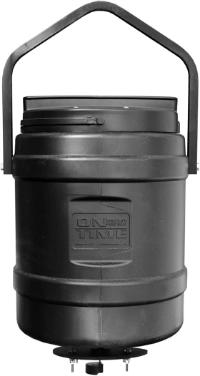
This series of feeders is available in two different sizes:
- The Shakedown Feeder
- The Shakedown XL Feeder (which can be seen here)
Both models take a very interesting approach to the way the deer food is distributed. Instead of using a spinner to throw feed out, the Shakedown feeders use a vibration feature that drops feed from the feeder’s bottom.
One advantage to this vibrating action over a spinning type of feed dispenser is the vibration technology is much less apt to jam and can handle just about every kind of dry deer feed on the market.
The downside to this approach is the feed drops to the ground and is not “thrown” like a spinner-type feed dispenser.
Both models are manufactured from polymer and run on a 6-volt battery. The standard Shakedown model features a 10 gallon (roughly 40 pounds) hopper, while the XL model comes with a 20 gallon (approximately 80 pounds) hopper.
The 7400 model Shakedown weighs 11 pounds, so it’s lightweight for easy transport. In addition, the timer in this model can be adjusted to run in intervals of 1 second to 30 seconds and can be programmed to release feed up to 6 times per day. Just a word of warning: if you set this feeder up to run in a 30-second interval, it will dispense nearly 2 gallons of feed in one session.
Pros
Unique technology is much quieter than a standard spinner-style disbursement system.
One of the more manageable programmable feeder units to program (some are more complicated than others).
Component-based platform, so the feed motor is easy to replace if needed.
This model can disperse nearly any type of deer feed or deer attractant on the market, no matter how small or large.
Cons
While the polymer is very durable to the elements, it won’t hold up as well as steel to pests like squirrels and bears.
Does not include a varmint guard, so one would have to be purchased separately.
Moultrie 6.5 Gallon Pro Hunter II Hanging Feeder (Model MFG-13058)
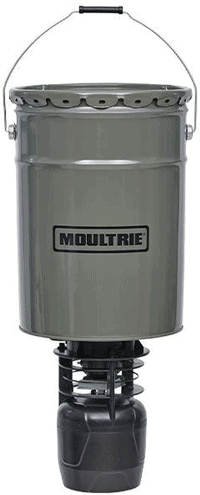
If the Moultrie Pro Mag Plus feeder I mentioned above is more than you want to spend, then you may want to check out the Moultrie 6.5 Gallon Pro Hunter II feeder.
This model is the 2nd generation version of the Pro Hunter Hanging Feeder series from Moultrie and is built with a 6.5-gallon hopper (which equals about 40 pounds of feed). Thus, this model is much smaller than the 30 gallon Pro Mag Plus feeder I discussed previously.
Both the hopper and hopper lid are metal, with the mounted feeder motor kit being housed in plastic. Like most of the Moultrie feeders, Pro Hunter II also features a metal varmint guard. In addition, this unit uses a broadcast-style dispersal system integrated with a programmable timer.
This model can be programmed to dispense feed up to 6 times per day with feed intervals of 1-second to 20-second bursts. The feed motor is powered by a 6-volt battery (which is not included). It will accept either a traditional alkaline 6-volt battery or a rechargeable 6-volt battery.
Like some of the other hanging-style deer feeders on this list, the Pro Hunter II is buckle-style with a standard bucket handle as an attachment point. However, this design is not as robust or heavy-duty as the Moultrie Pro Mag Plus feeder that is also on this list.
Like most of the Moultrie feeder products, this unit also has some available upgrades that be purchased separately. These include a Moultrie branded 6-volt rechargeable battery, charging cable, and solar charging power panel.
Pros
Works with a rechargeable battery and can integrate with a solar charging panel.
Offers a good value for the money.
Somewhat component-based, so parts (such as a new feeder motor) are easy to acquire and install.
Cons
The marketing materials for this model are a bit misleading as a 6-volt battery is not included.
While durable, the handle attachment will not withstand abuse from a bear if they reach the feeder.
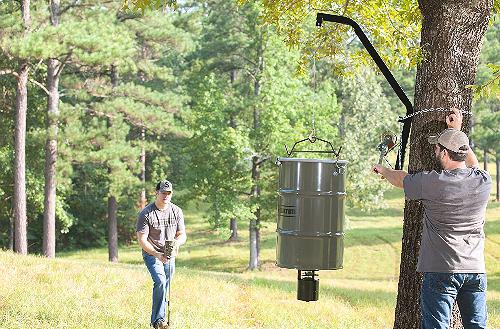
Hanging Deer Feeder Buying Guide
When shopping for a new hanging style deer feeder, there are a few important features or details to understand when you start the shopping process. Here’s an overview of those features or details:
Feed Capacity
This term refers to how much feed or attractant the feeder can support. This number is typically presented in either gallons or pounds. However, as there is a significant volume difference between a gallon and a pound, it’s essential to pay attention to the feeder capacity details.
For example, a 30-gallon feeder will hold about 200 pounds of feed, while a feeder with a 30-pound capacity will hold 30 pounds of feed. That’s a 170-pound capacity difference based on the word “gallon” versus “pound.”
The area on a feeder unit that stores the feed is commonly called the hopper. The capacity can also play a role in how often the feeder has to be refilled. Feeders with a smaller hopper may have to be restocked with feed more often than a feeder with a larger capacity hopper. However, other factors can play a role in how often a feeder has to be refilled, so it’s not just based on hopper capacity.
Weight
When discussing the weight of a hanging deer feeder, you’d got two numbers to consider:
- The actual weight of the feeder itself
- Weight of the feeder when filled
Actual Feeder weight
This number is the base weight of the feeder without being filled with feed. The base weight can play a role in the ability to transport and set up the feeder. While lighter always sounds better, the more lightweight feeder models are usually made from polymer or plastic. While this material is very durable, it doesn’t tend to hold up well against pests with teeth. Bears, squirrels, and raccoons may be able to chew through the plastic to access the feeder food stored in the hopper.
Weight of the feeder when filled
This number is the total weight of the feeder when filled. To figure out this number in pounds, you need to take the base weight of the feeder and add the estimated weight of the feed in the hopper.
So, a 30-gallon hanging feeder that weighs 50 pounds unloaded ends up weighing nearly 250 pounds when fully loaded with feed.
This number can be vital as it’s the total weight that you’ll be trying to hoist up off the ground each time to refill the feeder. For smaller feeder models, it’s not too tricky to hoist manually. However, for larger feeder models, I prefer to use a winch or pulley system.
Feeder Material
Although I’ve previously touched on this topic above, it’s worth discussing in more detail. For the most part, hanging feeders are manufactured from three different materials:
- Ballistic nylon
- Polymer or plastic
- Metal or steel
Ballistic nylon
Hanging style deer feeders made from ballistic nylon are generally the least expensive and the lightest available. In most cases, feeders made from this material are basically hanging bags of feed that dispense via gravity or a small motor.
I did not recommend or suggest any of these style feeders in my recommendations above because this material is not strong enough to protect the feed from pests. Squirrels can usually chew through this material in a few days and will actually enter the feeder to eat. If a bear comes across this style of feeder and can get to it, it won’t last an hour.
Polymer or plastic
Polymer is a popular material for all types of deer feeders and has several pros and cons as a material.
The biggest pros are the lower cost compared to a steel feeder and the lower weight associated with feeders made from this material. The reduced weight is a plus if you happen to be in a situation where you have to carry the feeder by hand for longer distances.
The single most significant downside to this material is its ability to repel pests. While polymer is very durable and withstands the elements exceptionally well, almost any animal with teeth can chew through it. I’ve seen situations where squirrels chewed through the lid of a plastic deer feeder in less than two days.
Metal or steel
This material is the most durable and long-lasting for feeders but comes at the price of a higher average cost and heavier weight.
Because the material is heavier, most metal hanging feeders have a slightly smaller hopper capacity compared to a polymer model. In addition, metal (especially at the seams) is prone to rust when exposed to the elements for long periods.
When it comes to repelling pests and vermin, metal feeders offer the best level of protection.
While I’ve suggested some polymer feeder models in my recommendations above, I prefer metal feeders as my experience has been that they hold up better over time.
Timer Capability
With the exception of the most basic hanging feeder models, most are equipped or designed to be used with a timer that operates the feed dispersal schedule.
Having a timer is also a bit of a double-edged sword as it offers significant flexibility for a feed schedule but also requires a power source. Typically, the power source is a battery or batteries, and those will have to be replaced at some point.
Given a choice between a non-timer-equipped feeder and one with a timer, I prefer the flexibility offered by the timer model. It allows me to configure a feed schedule to my personal preferences.
Battery Requirements
With the exception of a gravity-based feeder, most deer feeder models require a power source to operate the timer and/or feeder motor unit. That power source is nearly always battery-based.
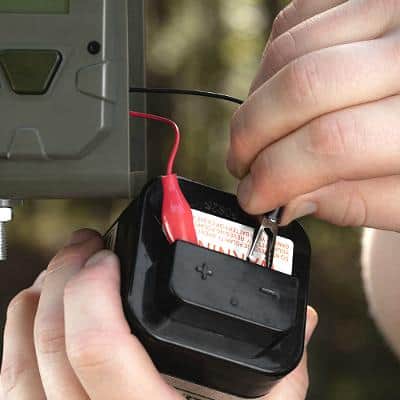
When discussing deer feeder batteries, there are different sizes and types common to feeders. Typically, batteries will fall into one of two categories:
- Disposable alkaline batteries
- Rechargeable batteries
Some feeders are designed for use with smaller batteries, such as AA batteries or C-sized batteries, while others require a larger 6-volt or 12-volt battery. In addition, each feeder brand has its own battery preferences. For example, the Moultrie brand of feeders typically uses a 6-volt battery, while the On Time brand of feeders typically uses an AA-sized or C-sized battery pack.
I prefer feeder models that accept rechargeable batteries but have owned models that used disposable batteries or battery packs as well. I also like feeder units that are integrated with solar charging so that the battery or batteries can be charged with a solar cell or panel.
Feeder Warranty
Most feeder models come with a warranty of some type, but most are very limited in scope, so they end up offering very little coverage. I’ve only seen a few occasions where a feeder was replaced under warranty, and it usually involved being damaged or defective upon receipt.
In my experience, once the feeder is deployed, you’ll be hard-pressed to get anything replaced under warranty.
I’ve always looked at feeder warranties the same way I look at tire warranties. I know the feeder will break at some point, but I want to get as much use out of it as possible.
Durability
When discussing feeder durability, I usually break the conversation down into two main durability components:
- Hopper durability
- Motor durability
Let’s go a bit deeper into each topic:
Hopper durability
When it comes to the durability of the hopper or the location where the feed is stored, feeder models made from steel or metal are by far the most durable. Polymer feeders come in a distant second for durability, and nylon or cloth feeders come in dead last for durability.
Motor durability
I haven’t really noticed a difference in motor durability between the different feeder brands, so I can’t say one brand offers a superior feeder motor compared to another.
Motor durability is a bit different as the durability can be tied to the volume of feedings. Each feeder motor has an expected life of XX number of activations before it fails. Some may die sooner, while others may perform well beyond their expected lifespan.
However, in my experience, the feeder motor on a model set to run twice a day will last longer than the motor on a feeder set to run six times a day. Therefore, I try to balance the number of daily feedings against the motor lifespan in an effort to get as much use as possible.
I also prefer to use feeder brands built on a component-based system where the feeder motor can be removed and replaced versus replacing the entire feeder unit if the motor fails.
Varmint or Pest Control
I’ve mentioned several times in this article that it’s an essential factor in a buying decision. Certain varmint or pest species are guaranteed to do two things to a deer feeder:
- Eat the feed on the ground
- Try to break into the feeder to access more feed
There really isn’t a way to stop those species from eating the feed off the ground, so that’s just an issue that you kind of live with.
The real issue comes when those species try to access the feeder to get to the feed inside. This is when the feeder gets damaged or feed is lost.
For the most part, here are the species that are the typical problems for a deer feeder:
- Bears
- Raccoons
- Squirrels
Here’s a little more information on each species and the common problems they cause:
Bears
I live and hunt in the great state of North Carolina, so when I talk about bears, I’m referring to the American black bear species.
Black bears are omnivores who love an easy meal and will return to a feeder regularly to feed. However, once they have eaten all the feed off the ground, they may (and usually do) try to break into the feeder if they can access it.
This species can grow to several hundred pounds and is a powerful animal. They can destroy a feeder pretty quickly, but only if they can get access to it. Black bear deterrence is one of the areas where hanging feeders offer a better option than tripod feeders because a hanging feeder can be positioned high enough off the ground where a bear is not tall enough to get to it.
However, black bears are excellent tree climbers and will scale a tree in a minute to get to a loaded deer feeder. The best way to combat this is to place the feeder in a position far enough away from the base of the tree so that the bear cannot get to it without the risk of falling.
Another approach to keep bears away from a hanging feeder is this: (shared by a customer from my day job)
- Attach a steel cable between two trees at least 15 to 20 feet off the ground.
- Suspend the feeder from another steel cable and mount it directly to the center of the suspended steel between the trees.
With this approach, the bear will have to climb out of the suspended steel cable to access the feeder, and all but the most determined bear won’t like that.
Here’s a picture of that setup from a hunting forum.
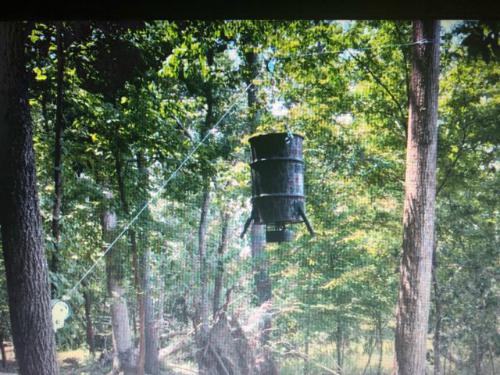
Sourced from https://nchuntandfish.com/forums/index.php?threads/hanger-for-deer-feeder.32362/
Raccoons
Raccoons are another species that are potential pests at a deer feeding site. While primarily nocturnal, raccoons will come to visit a feeder to eat during the day.
They will routinely eat the feed on the ground and may try to get into the feeder when all the ground feed has been consumed. If a raccoon successfully breaches the feeder, the feed will be consumed within a few days.
While raccoons do not possess the cutting teeth found with squirrels, they can and will chew into a polymer or plastic feeder. In addition, raccoons will explore every aspect of a feeder with their paws and are surprisingly good at opening doors or hatches. They are exceptionally persistent and will become even more persistent in the winter when their natural food sources dwindle.
The only way to deter raccoons from a feeder is to position them in such a way that they have several obstacles to get over or around to access the hanging unit.
One trick that I’ve tried with limited success is to mount a galvanized steel trashcan lid on the chain or rope being used to suspend the feeder. Mount it about 4 or 5 feet above the feeder so that they have to try to climb over the lid to access the feeder. It works for the less determined ones, but the really stubborn raccoons will find a way around it or fall trying.
It’s a bit of a side note, but I find that trapping the raccoons using a contracted professional trapper is the easiest way to reduce the population around feeders (where legal, of course).
Squirrels
While bears seem to do the most damage to a feeder, I have to rate squirrels as a close second and, in some respects, can be worse than bears. I’ve only had a few feeder issues with bears in my hunting career (so far), but I catch squirrels on my feeders daily on camera.
While there are a few different species and sub-species of squirrels, I’m referring to the Eastern Gray squirrel.
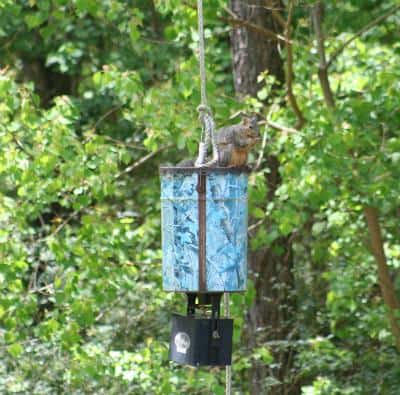
Since they are equipped with sharp teeth for cutting into nuts, squirrels will chew on any part of the feeder that they can get into their mouths.
Any feeder part made from a material softer than metal is likely to be chewed on, especially around the hopper or feed storage area. Where I hunt, squirrels are the most likely species to chew a feeder to pieces.
Squirrels are also creatures of habit and will return to the same feeder several times a day to feed. I once observed the same squirrel (identifiable through a clearly visible injury) on camera, visiting the same feeder six times in one day.
I wrote another post about this topic, discussing methods to keep raccoons and squirrels off a deer feeder.
FAQS
Can you talk about how to hang a deer feeder?
There are several different methods to hang a deer feeder, so please don’t think that the methods I listed below are your only options:
- Using a commercially made Hanger
- Hanging over a tree branch
- Hanging between two trees using a metal wire
Let’s go over each of these approaches in more detail:
Using a Commercially Made Hanger
If you do any research online, you’ll most likely come across several different commercially made devices for hanging a deer feeder.
To be completely honest, I’ve tried several and haven’t been really impressed with any. While commercial hangers are convenient, and many also offer an integrated winch or pulley, most place the feeder very close to the tree’s main trunk. This approach makes it easy for pests to climb the tree and get access to the feeder.
And then there are the costs associated with a commercial deer hanger. They range from $125 up to nearly $400 for the top-end models. So it’s just another added expense to the overall costs of running a feeder.
Hanging over a tree branch
I’ve used this method several times and had success with it. This approach involves running a wire, rope, chain, etc., over a tree branch and then using that same branch as a suspension point for the feeder.
The tree branch method is an economical approach, and it’s reasonably easy to set up.
The few suggestions I’ll make about this method are:
- Choose a sturdy branch that will support the weight of the feeder, especially during a storm or high winds.
- If possible, try to place the feeder as far away from the main tree trunk as possible, as that will help deter pests.
Hanging between two trees using a metal wire
In situations where possible, this has become my go-to approach for hanging deer feeders. Obviously, it requires two trees to be close together, so it may not work for every scenario.
This approach involves running a steel cable between two tall trees of a small diameter. I prefer smaller-diameter trees as these seem more difficult for bears to climb.
Once the cable is in place, you run another steel cable to the feeder, then run that cable over the center of the line between the two trees. I usually attach a U-bracket at the center of that cable to hold the suspension cable in place.
Then the feeder is hoisted up to a suitable height (which is usually at least 15 feet off the ground for me) and secured in place.









